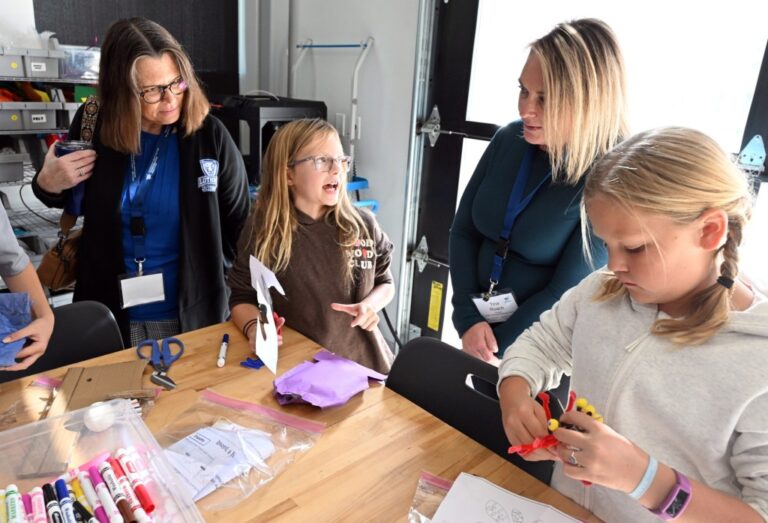St. Vrain Valley is sharing its innovation success with other school districts across the country this week. Theo Temme (left) and Levi Smith talk with Stacey Briggs, a visiting educator from Utah. The Leadership Institute for Transformative Education, a conference aimed at accelerating excellence in public education, will be held Oct. 22-24 at St. Vrain Valley School’s Innovation Center. Wednesday’s agenda includes field visits to four schools, including Soaring Heights K-8 in Erie. (Cliff Grassmick/Staff Photographer)
The three-day Leadership Institute for Transformative Education, hosted by St. Vrain Valley in partnership with the Colorado Education Initiative, concludes Thursday. The conference, held at the district’s Innovation Center in Longmont, will include school visits, Innovation Center program tours, student panel discussions, and a drone show by the Innovation Center’s student drone team.
Participants included leadership teams from 16 school districts representing 12 states.
“We can share what we’re doing and continue to connect with districts across the state and nation,” Superintendent Don Haddad said.
The district pointed to a combination of foundational academics and innovative programs, including quantum computing, AI and cybersecurity pathways for students, that have resulted in high test scores and graduation rates.
“Innovation is really pushing our system to another level,” he said. “Given how quickly things are changing, the education system needs to look at this kind of initiative.”
Adam Garry, Dean of StrategicEDU, gave a keynote address Wednesday on “The Curious World of Generative AI: Opportunities and Risks.” He signaled curiosity but caution about the emerging technology and recommended that districts develop guidelines for its use.
He pointed out that generative AI creates new content that is different each time, even for the same prompt. That superpower is creativity, he said, but it also has its limits. For example, he said it’s not a good idea to use it to grade writing because the same piece of work could get a different score each time.
“We have to stay on top of human information,” he said.
After the presentation, school leaders attended breakout sessions on topics such as community-business partnerships, creating a guaranteed curriculum, and restoring the narrative of public education.
In another session, several St. Vrain leaders shared approaches to connecting students to careers used in the district’s Career and Technical Education, Innovation Center, P-TECH and P-TEACH programs. P-TECH is a national early college program, while P-TEACH is a grow-your-own education program created by St. Vrain.
St. Vrain District Assistant Superintendent Dina Perfetti Deeney said the district is building a second career and technical education center in Weld County because of the high demand for programs such as welding, pre-legal education and construction. He said he proposed it. She added that all programs include a direct path to industry, community college or a four-year university.
“We’re not dead-end kids,” she said.
Other important factors, Perfetti-Deany said, are providing consistent high school block schedules and start times to ensure all students have access to classes, and limiting enrollment to upperclassmen and certain GPA students. He said that it should not be limited to students with
“We want to get at-risk students into these programs,” she says.
The afternoon included field visits to one of four schools: Frederick High School, Career Elevation and Technology Center, Soaring Heights PK-8, and Longmont Estates.
At Soaring Heights in Erie, participants heard from Principal Silas Weinberger about the school’s STEM neuroscience program, visited middle school classes, built prototypes and took on design challenges of their own. In one class, 8th graders aimed to keep plastic out of the ocean by designing ships using cardboard and other materials to better protect their cargo. In another example, Year 7 students used a specialized Lego kit to create mechanical claws for an underwater robot.
As Soaring Heights Vice Principal Anna Mills guided participants through design challenges using materials such as straws, paper clips, foil and coffee filters, she cautioned them not to worry about perfection.
“It’s a mess,” she said. “This is meant to show students what prototyping is really like.”
Although it’s impossible to exactly replicate St. Vrain’s program in her rural, 1,400-student district in Vermont, Assistant Superintendent Debbie Alexander said she plans to use innovative strategies already in place in the district. He said he is looking for ideas to make things more sustainable.
“It was very helpful,” she said.
Principal Paul Waechtler’s district consists of one 4,000-student high school in the Chicago suburbs. He said he is interested in creating more career paths for students.
“This gives us time away from campus to talk about bigger ideas,” he said.


